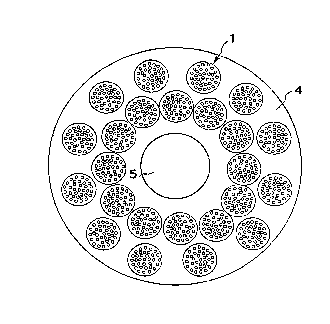Some of the information on this Web page has been provided by external sources. The Government of Canada is not responsible for the accuracy, reliability or currency of the information supplied by external sources. Users wishing to rely upon this information should consult directly with the source of the information. Content provided by external sources is not subject to official languages, privacy and accessibility requirements.
Any discrepancies in the text and image of the Claims and Abstract are due to differing posting times. Text of the Claims and Abstract are posted:
| (12) Patent: | (11) CA 2203427 |
|---|---|
| (54) English Title: | ABRASIVE PRODUCTS |
| (54) French Title: | ARTICLE ABRASIF |
| Status: | Expired and beyond the Period of Reversal |
| (51) International Patent Classification (IPC): |
|
|---|---|
| (72) Inventors : |
|
| (73) Owners : |
|
| (71) Applicants : |
|
| (74) Agent: | GOWLING WLG (CANADA) LLP |
| (74) Associate agent: | |
| (45) Issued: | 2000-05-23 |
| (86) PCT Filing Date: | 1995-08-09 |
| (87) Open to Public Inspection: | 1996-05-23 |
| Examination requested: | 1997-04-22 |
| Availability of licence: | N/A |
| Dedicated to the Public: | N/A |
| (25) Language of filing: | English |
| Patent Cooperation Treaty (PCT): | Yes |
|---|---|
| (86) PCT Filing Number: | PCT/US1995/010085 |
| (87) International Publication Number: | US1995010085 |
| (85) National Entry: | 1997-04-22 |
| (30) Application Priority Data: | ||||||
|---|---|---|---|---|---|---|
|
Coated abrasive materials can be made from a backing material andabrasive
elements which comprise abrasive particles adhered to a rigid base material,
said elements being rigidly adhered to the backing material in a predetermined
pattern.
Un article à surface abrasive peut être réalisé à partir d'un support et d'éléments abrasifs comprenant des particules abrasives adhérant à un matériau de base rigide; lesdits éléments adhèrent rigidement au support suivant un motif prédéterminé.
Note: Claims are shown in the official language in which they were submitted.
Note: Descriptions are shown in the official language in which they were submitted.

2024-08-01:As part of the Next Generation Patents (NGP) transition, the Canadian Patents Database (CPD) now contains a more detailed Event History, which replicates the Event Log of our new back-office solution.
Please note that "Inactive:" events refers to events no longer in use in our new back-office solution.
For a clearer understanding of the status of the application/patent presented on this page, the site Disclaimer , as well as the definitions for Patent , Event History , Maintenance Fee and Payment History should be consulted.
| Description | Date |
|---|---|
| Time Limit for Reversal Expired | 2011-08-09 |
| Letter Sent | 2010-08-09 |
| Grant by Issuance | 2000-05-23 |
| Inactive: Cover page published | 2000-05-22 |
| Inactive: Final fee received | 2000-02-29 |
| Pre-grant | 2000-02-29 |
| Notice of Allowance is Issued | 1999-12-22 |
| Notice of Allowance is Issued | 1999-12-22 |
| Letter Sent | 1999-12-22 |
| Inactive: Approved for allowance (AFA) | 1999-11-09 |
| Inactive: IPC assigned | 1997-08-04 |
| Inactive: First IPC assigned | 1997-08-04 |
| Inactive: IPC assigned | 1997-08-04 |
| Letter Sent | 1997-07-23 |
| Inactive: Acknowledgment of national entry - RFE | 1997-07-22 |
| All Requirements for Examination Determined Compliant | 1997-04-22 |
| Request for Examination Requirements Determined Compliant | 1997-04-22 |
| Application Published (Open to Public Inspection) | 1996-05-23 |
There is no abandonment history.
The last payment was received on 1999-07-21
Note : If the full payment has not been received on or before the date indicated, a further fee may be required which may be one of the following
Patent fees are adjusted on the 1st of January every year. The amounts above are the current amounts if received by December 31 of the current year.
Please refer to the CIPO
Patent Fees
web page to see all current fee amounts.
| Fee Type | Anniversary Year | Due Date | Paid Date |
|---|---|---|---|
| Registration of a document | 1997-04-22 | ||
| Basic national fee - standard | 1997-04-22 | ||
| Request for examination - standard | 1997-04-22 | ||
| MF (application, 2nd anniv.) - standard | 02 | 1997-08-11 | 1997-07-24 |
| MF (application, 3rd anniv.) - standard | 03 | 1998-08-10 | 1998-07-22 |
| MF (application, 4th anniv.) - standard | 04 | 1999-08-09 | 1999-07-21 |
| Final fee - standard | 2000-02-29 | ||
| MF (patent, 5th anniv.) - standard | 2000-08-09 | 2000-07-20 | |
| MF (patent, 6th anniv.) - standard | 2001-08-09 | 2001-07-19 | |
| MF (patent, 7th anniv.) - standard | 2002-08-09 | 2002-07-18 | |
| MF (patent, 8th anniv.) - standard | 2003-08-11 | 2003-07-21 | |
| MF (patent, 9th anniv.) - standard | 2004-08-09 | 2004-07-21 | |
| MF (patent, 10th anniv.) - standard | 2005-08-09 | 2005-07-20 | |
| MF (patent, 11th anniv.) - standard | 2006-08-09 | 2006-07-17 | |
| MF (patent, 12th anniv.) - standard | 2007-08-09 | 2007-07-25 | |
| MF (patent, 13th anniv.) - standard | 2008-08-11 | 2008-07-17 | |
| MF (patent, 14th anniv.) - standard | 2009-08-10 | 2009-07-21 |
Note: Records showing the ownership history in alphabetical order.
| Current Owners on Record |
|---|
| NORTON COMPANY |
| Past Owners on Record |
|---|
| GARY J. KARDYS |
| ROBERT G. KELLY |